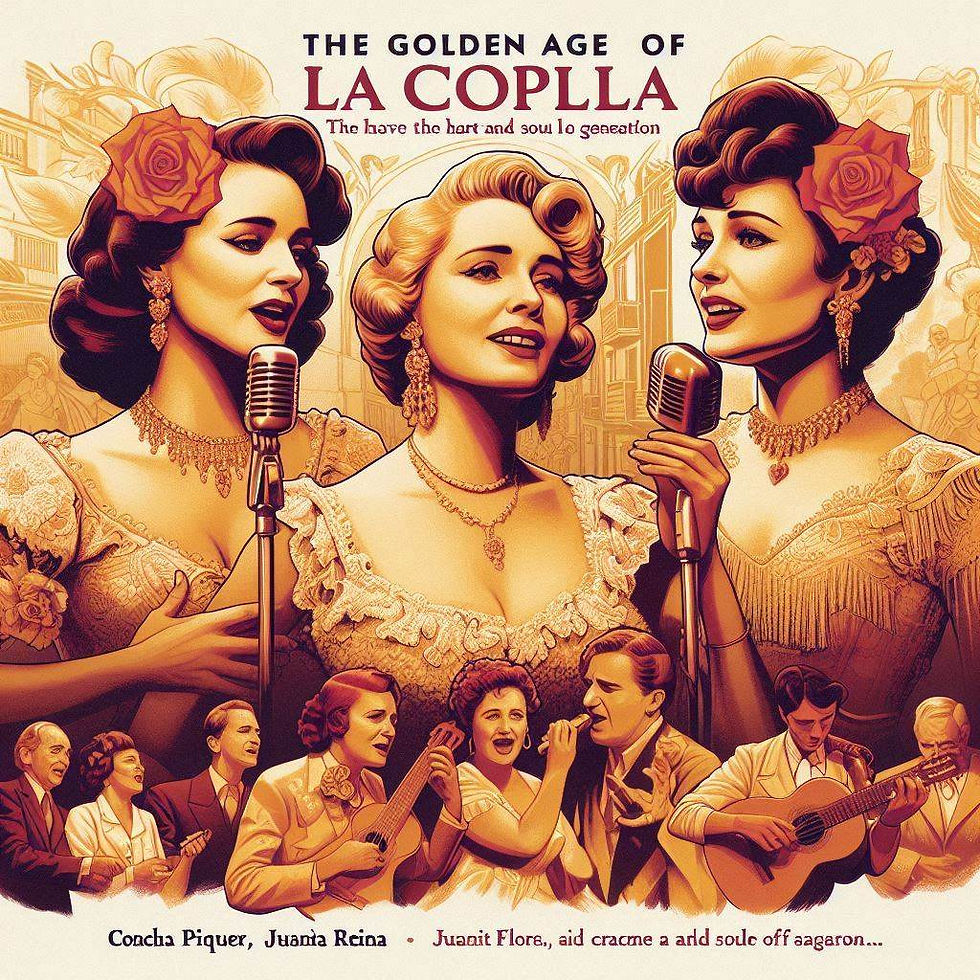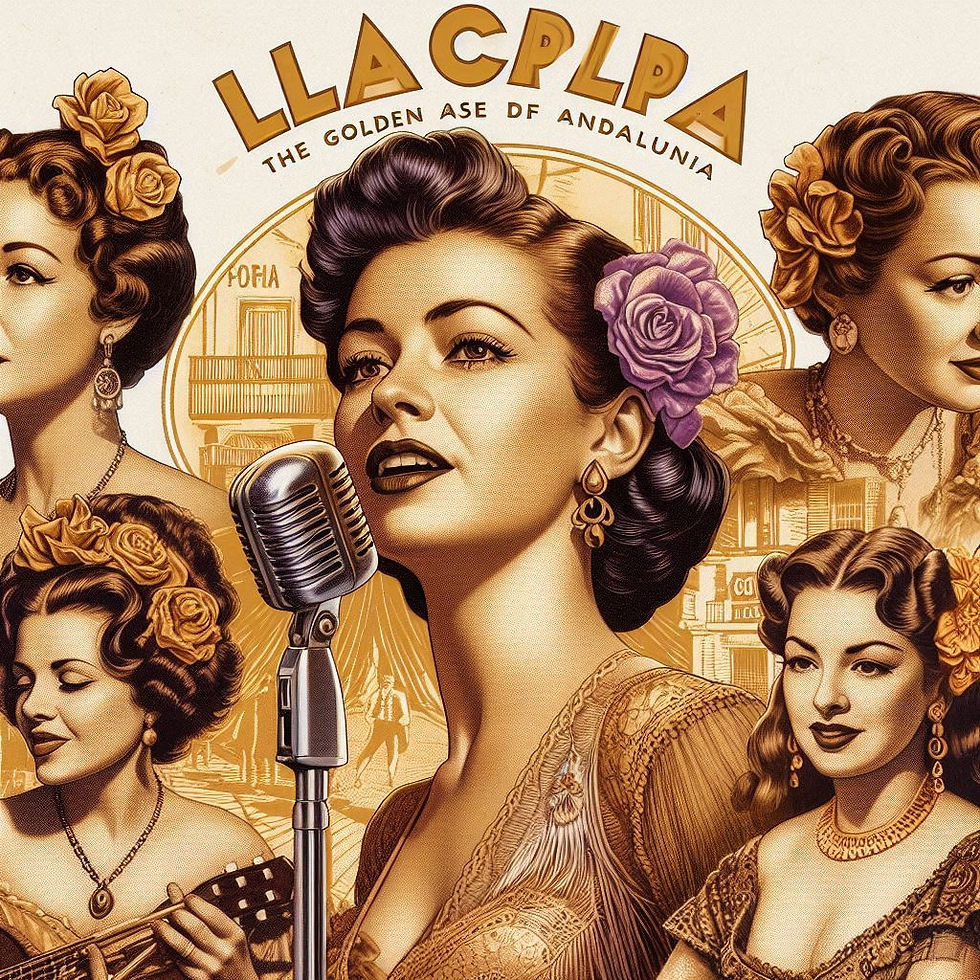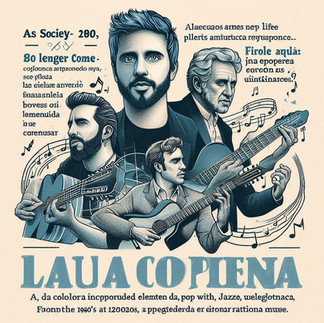La Copla Española: A Timeless Journey from Andalusian Streets to AI's Creative Heart
- Franco Arteseros
- 31 ago
- 3 Min. de lectura
The Soul of a Song
In the heart of Andalusia, where sunsets cast long shadows and the energy of life pulses through the air, a dimly lit tavern comes alive. The scent of sherry mixes with the soft rustle of silk dresses swirling like leaves in the wind. A lone guitarist, fingers ready at the strings, strikes the first chord, and silence envelops the room.

This is the world of La Copla, a musical genre that goes beyond entertainment—it's a vessel for memory, identity, and defiance. Each note carries echoes of history, revealing the struggles and victories of a people who have often felt overlooked. La Copla serves as a heartbeat, a rhythm that flows through the cobblestone streets of Seville and beyond, sharing stories of love, loss, and yearning.
Origins & Historical Roots
Understanding La Copla requires a journey through Spain's rich history, starting with medieval romances that captivated troubadours. These early ballads, rooted in Andalusia's oral traditions, laid the foundation for a musical style that evolved over the centuries.
The influence of Al-Andalus, especially its unique musical scales and haunting flamenco traditions, is vital. Between the 8th and 15th centuries, when Moors and Christians coexisted, their cultural exchange fostered a sound that became intrinsic to La Copla. By the late 19th century, the popular theater known as zarzuela began to solidify these musical traditions, leading to the golden age of La Copla from the 1930s to 1950s, when the genre became widely celebrated.
The Golden Age & Cultural Impact

The golden age of La Copla featured iconic singers who became the heart and soul of a generation. Concha Piquer, known for her powerful voice, and Juanita Reina, whose passionate performances struck a chord with audiences, captivated fans across Spain. Lola Flores, the "Flor de Andalucía," personified the spirit of La Copla, with each performance radiating celebration and resilience.

The themes in La Copla reflect the diverse fabric of Spanish life. For example, songs about love and betrayal or the struggles of exile and honor mirror the real-life experiences faced by many. During Franco's oppressive regime, La Copla became a subtle resistance tool, using metaphor and allegory to articulate truths that remained unspoken. In fact, it is estimated that around 70% of La Copla songs contained hidden political messages, providing a creative outlet during difficult times.

Folklore & Symbolism
At La Copla's core lies a rich tapestry of folklore and symbolism, where recurring images evoke deep emotions. For instance, the bullfighter often represents bravery and tragedy, while the abandoned lover gazes at the moon in sorrow. Ships at sea symbolize longing and uncertainty, navigating the choppy waters of romance and heartache.
These symbols connect deeply with broader Iberian folklore, linking La Copla to regional narratives. Each song acts as a unique story, a thread in a larger cultural tapestry that resonates with shared experiences, bridging communities across Spain.

Evolution & Modern Revivals
As society evolved, La Copla also transformed. From the 1980s to the early 2000s, interest resurged, with artists breathing new life into the traditional genre. Musicians blended Copla with pop, jazz, and electronic styles, attracting listeners of all ages. For example, the popular singer Pablo Alborán incorporated elements of La Copla in his music, drawing in younger audiences.
The genre found a welcoming space in LGBTQ+ cultural circles, where its themes of love and defiance resonated with those seeking acceptance. Additionally, Spanish diaspora communities adopted La Copla to connect with their roots, celebrating their heritage while navigating today’s complex world.
La Copla & AI — A New Verse
Imagine a future where AI takes on the role of a modern coplista, learning from the historical lyrics that shaped the genre. With algorithms designed to recognize meter and rhyme, AI could generate new verses that capture the emotional depth of traditional La Copla.
This fusion of technology and artistry presents exciting possibilities. As AI immerses itself in the masters' works, it could create a new dialect of La Copla that speaks to contemporary experiences while honoring its rich traditions.
A Lasting Legacy of Music
La Copla Española is not just music; it embodies the enduring spirit of resilience and identity. From the lively tapas bars of Andalusia to the emerging digital landscapes, its melodies continue to tell stories that bridge the past and present.
As we stand at the forefront of change, where AI and tradition meld, we are reminded that the essence of a song is timeless. La Copla remains a bridge between what was and what will be—a celebration of identity, memory, and the unbreakable bond music creates among us all.
KIKO ARTESEROS...
































Comentarios